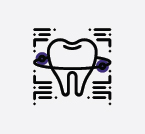

Whitening
Whitening your teeth too often increases the risk of negative side effects, such as tooth sensitivity and damage to tooth enamel and gums. But there’s no official guideline for how often whitening can be done safely. That’s why it’s important to get your dentist’s recommendation and always follow product instructions.

Composite Fillings
Composite resins, or tooth-colored fillings, provide good durability and resistance to fracture in small- to mid-size fillings that need to withstand moderate pressure from the constant stress of chewing. They can be used on either front or back teeth. They are a good choice for people who prefer that their fillings look more natural.

Cosmetic Contouring
Cosmetic contouring (also known as odontoplasty or teeth reshaping) is a simple procedure that removes some of your enamel to change the form of your tooth or teeth. The goal of cosmetic contouring is to alter your teeth’ shape, length, or appearance to improve your look.

Excessive or Uneven Gums
Excessive, uneven gums can be caused by a lot of factors. Genetics, medical conditions, and some medications can all cause overgrown, puffy, uneven gum tissue. Poor oral hygiene can also dramatically affect your gums.

Flap Surgery
Flap surgery is a technique in plastic and reconstructive surgery where any type of tissue is lifted from a donor site and moved to a recipient site with an intact blood supply. This is distinct from a graft, which does not have an intact blood supply and therefore relies on growth of new blood vessels.

Jaw/TMJ
The temporomandibular joint or TMJ acts like a sliding hinge, connecting your jawbone to your skull. Dysfunction can lead to pain and discomfort.
Jaw pain, difficulty chewing, and clicking and locking of the jaw joint are some of the symptoms.
Common treatments include medications, bite guards, and physical therapy.
Jaw pain, difficulty chewing, and clicking and locking of the jaw joint are some of the symptoms.
Common treatments include medications, bite guards, and physical therapy.

Porcelain Veneers
There are two main types of material used to fabricate a veneer: composite and dental porcelain. A composite veneer may be directly placed (built-up in the mouth), or indirectly fabricated by a dental technician in a dental lab, and later bonded to the tooth, typically using a resin cement. They are typically used for treatment of adolescent patients who will require a more permanent design once they are fully grown.

Crowns
A crown or a dental cap is a type of dental restoration that completely caps or encircles a tooth or dental implant. A crown may be needed when a large dental cavity threatens the health of a tooth. A crown is typically bonded to the tooth by dental cement. They can be made from various materials, which are usually fabricated using indirect methods. Crowns are used to improve the strength or appearance of teeth and to halt deterioration.

Bridges
Conventional bridges are bridges that are supported by full coverage crowns, three-quarter crowns, post-retained crowns, onlays and inlays on the abutment teeth. In these types of bridges, the abutment teeth require preparation and reduction to support the prosthesis. Conventional bridges are named depending on the way the pontic (false teeth) is attached to the retainer.

Fillings
To treat a cavity your dentist will remove the decayed portion of the tooth and then “fill” the area on the tooth where the decayed material was removed. Fillings are also used to repair cracked or broken teeth and teeth that have been worn down from misuse (such as from nail-biting or tooth grinding).

Dentures and Partials
Complete Dentures
Complete dentures can be either “conventional” or “immediate.” Made after the teeth have been removed and the gum tissue has begun to heal, a conventional denture is ready for placement in the mouth about eight to 12 weeks after the teeth have been removed.
Partial Dentures
A removable partial denture or bridge usually consists of replacement teeth attached to a pink or gum-colored plastic base, which is sometimes connected by metal framework that holds the denture in place in the mouth. Partial dentures are used when one or more natural teeth remain in the upper or lower jaw.
Complete dentures can be either “conventional” or “immediate.” Made after the teeth have been removed and the gum tissue has begun to heal, a conventional denture is ready for placement in the mouth about eight to 12 weeks after the teeth have been removed.
Partial Dentures
A removable partial denture or bridge usually consists of replacement teeth attached to a pink or gum-colored plastic base, which is sometimes connected by metal framework that holds the denture in place in the mouth. Partial dentures are used when one or more natural teeth remain in the upper or lower jaw.

Cleaning and Sealants
A dental treatment intended to prevent tooth decay. Teeth have recesses on their biting surfaces; the back teeth have fissures (grooves) and some front teeth have cingulum pits. It is these pits and fissures that are most vulnerable to tooth decay because food and bacteria stick in them and because they are hard-to-clean areas.
Dental sealants are materials placed in these pits and fissures to fill them in, creating a smooth surface which is easy to clean. Dental sealants are mainly used in children who are at higher risk of tooth decay, and are usually placed as soon as the adult molar teeth come through.
Dental sealants are materials placed in these pits and fissures to fill them in, creating a smooth surface which is easy to clean. Dental sealants are mainly used in children who are at higher risk of tooth decay, and are usually placed as soon as the adult molar teeth come through.

Scaling and Root Planing
Dentists typically use periodontal scaling and root planing as the first steps in the treatment of gum disease.
Your dentist will scrape away all your plaque and tartar on your teeth — scaling — both above and below your gum line, down to the periodontal pocket.
After removing plaque, your dentist will plane, or smooth out, the rough surfaces on the roots of your teeth. This will help your gums reattach to your teeth.
Depending on your condition, periodontal scaling and root planing may take more than one dental visit. After this treatment, you may need a post-procedure checkup.
Your dentist will scrape away all your plaque and tartar on your teeth — scaling — both above and below your gum line, down to the periodontal pocket.
After removing plaque, your dentist will plane, or smooth out, the rough surfaces on the roots of your teeth. This will help your gums reattach to your teeth.
Depending on your condition, periodontal scaling and root planing may take more than one dental visit. After this treatment, you may need a post-procedure checkup.

Extractions
Although permanent teeth were meant to last a lifetime, there are a number of reasons why tooth extraction may be needed. A very common reason involves a tooth that is too badly damaged, from trauma or decay, to be repaired.
Dentists and oral surgeons (dentists with special training to perform surgery) perform tooth extractions. Before pulling the tooth, your dentist will give you an injection of a local anesthetic to numb the area where the tooth will be removed. In some instances, your dentist may use a strong general anesthetic. This will prevent pain throughout your body and make you sleep through the procedure.
If the tooth is impacted, the dentist will cut away gum and bone tissue that cover the tooth and then, using forceps, grasp the tooth and gently rock it back and forth to loosen it from the jaw bone and ligaments that hold it in place. Sometimes, a hard-to-pull tooth must be removed in pieces.
Dentists and oral surgeons (dentists with special training to perform surgery) perform tooth extractions. Before pulling the tooth, your dentist will give you an injection of a local anesthetic to numb the area where the tooth will be removed. In some instances, your dentist may use a strong general anesthetic. This will prevent pain throughout your body and make you sleep through the procedure.
If the tooth is impacted, the dentist will cut away gum and bone tissue that cover the tooth and then, using forceps, grasp the tooth and gently rock it back and forth to loosen it from the jaw bone and ligaments that hold it in place. Sometimes, a hard-to-pull tooth must be removed in pieces.

Non-Surgical Periodontal Therapy
Non-surgical periodontal therapy requires a deep cleaning with scaling and root planing. This procedure is a precise cleaning of the root surfaces to eliminate plaque and tartar from those deep periodontal pockets.

Root Canal Therapy
What is a root canal? Root canal treatment is a dental procedure that relieves pain caused by an infected or abscessed tooth. During the root canal process, the inflamed pulp is removed. The surfaces inside the tooth are then cleaned and disinfected, and a filling is placed to seal the space.